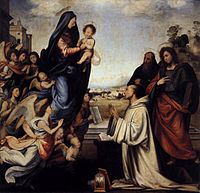Njozi za Bikira Maria





Njozi za Bikira Maria ni maono ya Bikira Maria yaliyoripotiwa na watu mbalimbali, hasa Wakristo wa madhehebu mbalimbali, kwamba yamewapata nje ya ndoto, na kwamba walimuona akiwa yuko sehemu fulani, na si kusikia tu sauti yake [1].
Njozi zinaweza zikawa za kweli au siyo. Mtu anaweza akadanganya kwa makusudi, anaweza akadanganyika mwenyewe katika inavyofafanuliwa na saikolojia kwa nafasi mbalimbali[2], lakini kwa wenye imani ya dini ni jambo ambalo linawezekana kutokea kweli[3].
Kwao Bikira Maria kutokea watu ni uthibitisho wa uwajibikaji wake kama mama wa Kanisa na wa waumini wake. Anaweza kuwatokea kuitikia maombi yao, kuahidi msaada wake[4] , kufariji au kuonya, akikumbusha kweli za imani na maadili yanayotakiwa n.k.[5]
Kanisa Katoliki lina taratibu zake katika kutathmini ukweli wa njozi hizo; kati ya vigezo vinavyotumika kuna unyofu na uadilifu wa wanaodai kutokewa, usahihi wa imani wa ujumbe wanaosimulia wamepewa, matunda mazuri yanayofuata [6].
Pamoja na kwamba Kanisa hilo limekataa njiozi nyingi[7], hata likithibisha ukweli wa njozi fulani, hakuna anayelazimika kuiamini kwa sababu ni mafunuo binafsi tu[8][9], ambayo ni tofauti na ufunuo rasmi uliokamilika wakati wa Mitume wa Yesu.
Njozi kadhaa za Bikira Maria zimeathiri sana maisha ya watu, kama ile ya Bikira Maria wa Guadalupe huko Mexico ambayo iliwavuta wakazi asili kukubali ubatizo kwa mamilioni na ni sehemu ya utambulisho wa taifa.
Mara nyingi njozi zinasababisha ujenzi wa patakatifu panapokuwa mahali pa hija kwa wengi, karne hata karne[10][11][12], lakini pia uanzishwaji wa mashirika ya kitawa, vyama vya kitume, sala mpya n.k.
Tanbihi[hariri | hariri chanzo]
- ↑ Zimdars-Swartz, Sandra L. (2014). Encountering Mary: From La Salette to Medjugorje. Princeton University Press. uk. 4. ISBN 9781400861637.
An apparition is best understood as a specific kind of vision in which a person or being not normally within the visionary's perceptual range appears to that person, not in a world apart as in a dream, and not as a modification of a concrete object as in the case of a weeping icon or moving statue, but as part of the environment, without apparent connection to verifiable visual stimuli.
- ↑ The Catholic Church believes that it is possible for actually-supernatural Marian apparitions to occur, but also believes that many claimed apparitions are fabricated by the seer or the result of something other than divine intervention. For this reason, the Catholic Church has a formal evaluation process established for assessing claimed apparitions.
- ↑ Believers consider such apparitions to be real and objective interventions of divine power, rather than subjective experiences generated by the perceiving individuals, even in cases where the apparition is reportedly seen by only some, not all, of the people present at the event's location.
- ↑ Apparitions are often accompanied by other alleged supernatural phenomena, such as medical cures.
- ↑ Dictionary of Mary, Catholic Book Publishing Co. New York. 1985, Imprimatur, p25-26
- ↑ "Norms Regarding the Manner of Proceeding in the Discernment of Presumed Apparitions or Revelations". Congregation for the Doctrine of the Faith. 1978-02-24.
- ↑ "Apparitions Statistics, Modern : University of Dayton, Ohio". udayton.edu. Iliwekwa mnamo 2020-06-19.
- ↑ Kosloski, Philip (2019-05-15). "This map illustrates 500 years of Mary's apparitions". Aleteia. Iliwekwa mnamo 2019-10-07.
Even if the Church recognizes an apparition as worthy of belief, no Catholic is obligated to believe in any private revelation, such as an apparition. The Church simply says that a person can find spiritual aid from an apparition, if he or she so chooses.
- ↑ "Private and public revelation". Catholic Culture. Iliwekwa mnamo January 11, 2012. Check date values in:
|accessdate=(help) - ↑ "Shrine Of Guadalupe Most Popular In World", Zenit News, June 13, 1999
- ↑ "Religion moves 330 million tourists a year and six million go to Fátima" Archived 5 Desemba 2018 at the Wayback Machine., Diário de Notícias, February 19, 2017.
- ↑ "Fátima expects to receive 8 million visitors in 2017", in Sapo20, December 15, 2016.
Marejeo mengine[hariri | hariri chanzo]
- McClure, Kevin (1983). The Evidence for Visions of the Virgin Mary. Wellingborough: Aquarian Press. ISBN 0-85030-351-6.
- Laurentin, René (1991) [1990]. The Apparitions of the Blessed Virgin Mary Today. Dublin: Veritas Publications. ISBN 1853901199.
- Odell, Catherine M. (1995). Those Who Saw Her: Apparitions of Mary. Huntington: Our Sunday Visitor. ISBN 0-87973-664-X. Ilihifadhi kwenye nyaraka kutoka chanzo mnamo 2022-08-29. Iliwekwa mnamo 2022-08-29.
- Connell, Janice T. (1996). Meetings with Mary: Visions of The Blessed Mother. United States: Ballantine Books. ISBN 0-345-39705-3. Unknown parameter
|url-access=ignored (help) - Sparrow, G. Scott (2004). Sacred Encounters with Mary. Chicago: Thomas More Association/Ave Maria Press. ISBN 1-59471-047-3.
- Cruz, Joan Carroll (2012). See How She Loves Us: 50 Approved Apparitions of Our Lady. Charlotte NC: TAN Books. ISBN 9780895557186.
- Maunder, Chris. Our Lady of the Nations: Apparitions of Mary in 20th-century Catholic Europe, Oxford University Press, 2016 ISBN|9780198718383
- Zimdars-Swartz, Sandra L., Encountering Mary: From La Salette to Medjugorje, Princeton University Press, 2014, ISBN|9781400861637

